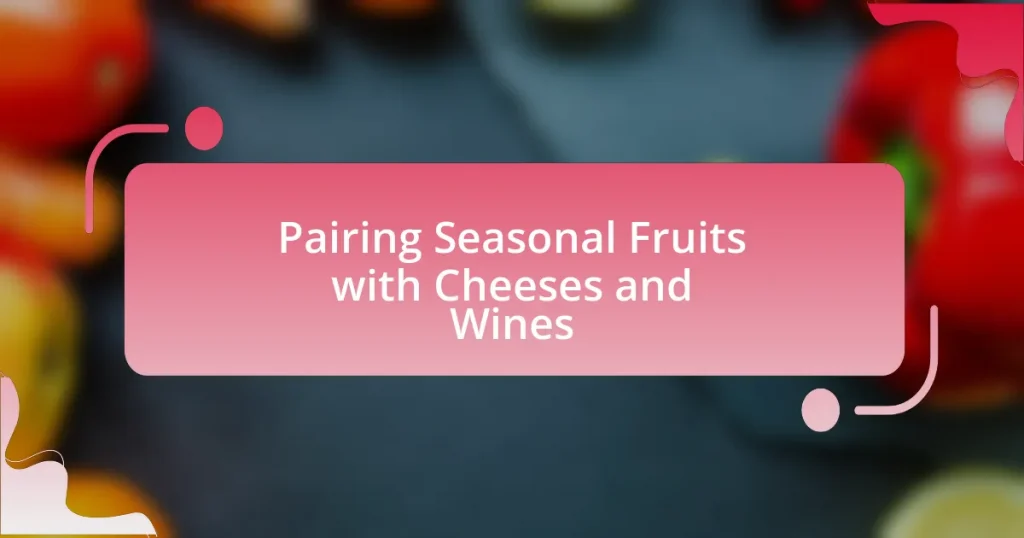Pairing seasonal fruits with cheeses and wines is a culinary practice that enhances flavors and creates a harmonious tasting experience. This article explores the principles of flavor compatibility, texture contrast, and the significance of seasonal availability in achieving successful pairings. It discusses how seasonal fruits influence flavor profiles, the benefits of using fresh ingredients, and the role of wine in complementing these combinations. Additionally, the article provides practical tips for selecting the right pairings, common mistakes to avoid, and strategies for hosting a successful pairing event, ensuring an enjoyable and memorable experience.

What is Pairing Seasonal Fruits with Cheeses and Wines?
Pairing seasonal fruits with cheeses and wines involves the art of combining these three elements to enhance flavors and create a harmonious tasting experience. This practice is rooted in the understanding that certain fruits, cheeses, and wines complement each other based on their flavor profiles, textures, and seasonal availability. For example, ripe summer peaches can pair beautifully with creamy goat cheese and a light, fruity white wine like Sauvignon Blanc, as the acidity in the wine balances the sweetness of the fruit and the richness of the cheese. This method of pairing is supported by culinary traditions and expert recommendations, emphasizing the importance of seasonal ingredients for optimal taste and freshness.
How does the pairing process enhance the tasting experience?
The pairing process enhances the tasting experience by creating complementary flavors that elevate the overall enjoyment of food and drink. When seasonal fruits are paired with cheeses and wines, the contrasting and harmonious elements interact, resulting in a more complex flavor profile. For instance, the acidity of a crisp apple can balance the creaminess of a rich brie, while a sweet dessert wine can enhance the natural sugars in ripe peaches. This synergy not only intensifies individual flavors but also stimulates the palate, making the tasting experience more memorable and satisfying.
What are the key elements to consider in pairing?
The key elements to consider in pairing seasonal fruits with cheeses and wines include flavor compatibility, texture contrast, and seasonal availability. Flavor compatibility ensures that the sweetness or acidity of the fruit complements the creaminess or saltiness of the cheese and the tannins or acidity of the wine. For example, pairing a sweet pear with a sharp blue cheese enhances both flavors. Texture contrast adds interest; a crunchy apple can balance a soft cheese, while a creamy cheese can enhance the juiciness of a ripe fruit. Seasonal availability is crucial as it ensures freshness and optimal flavor; for instance, pairing summer berries with a light white wine is more appealing when the berries are in season. These elements collectively enhance the overall tasting experience.
How do seasonal fruits influence flavor profiles?
Seasonal fruits significantly influence flavor profiles by introducing unique tastes and aromas that vary throughout the year. For instance, summer fruits like peaches and berries provide bright, sweet flavors that can enhance the richness of cheeses and the complexity of wines. In contrast, winter fruits such as citrus and apples offer tartness and acidity, which can balance creamy or fatty cheese textures and complement the oakiness of certain wines. Research indicates that the freshness and peak ripeness of seasonal fruits contribute to their enhanced flavor intensity, making them ideal for pairing with various culinary elements.
Why is seasonality important in food pairing?
Seasonality is important in food pairing because it enhances flavor, freshness, and nutritional value. Seasonal ingredients are typically harvested at their peak ripeness, resulting in superior taste and texture, which significantly improves the overall dining experience. For example, pairing summer fruits like peaches with creamy cheeses or crisp white wines maximizes the flavor profiles, as these ingredients complement each other when they are at their freshest. Additionally, using seasonal produce supports local agriculture and reduces environmental impact, as these ingredients require less transportation and storage. This practice not only promotes sustainability but also encourages consumers to enjoy foods that are naturally aligned with the time of year, leading to more harmonious and enjoyable pairings.
What are the benefits of using seasonal fruits?
Using seasonal fruits offers numerous benefits, including enhanced flavor, nutritional value, and environmental sustainability. Seasonal fruits are typically harvested at their peak ripeness, resulting in superior taste and texture compared to out-of-season varieties. For example, strawberries in June are sweeter and juicier than those available in winter. Nutritionally, seasonal fruits often contain higher levels of vitamins and antioxidants, as they are fresher and have not undergone long storage or transportation. Additionally, choosing seasonal fruits supports local agriculture, reduces carbon footprints associated with transportation, and promotes biodiversity by encouraging the consumption of a variety of fruits throughout the year.
How does seasonality affect cheese and wine selection?
Seasonality significantly influences cheese and wine selection by dictating the availability of fresh ingredients and the flavor profiles that complement seasonal produce. For instance, during warmer months, lighter cheeses like goat cheese and fresh mozzarella pair well with crisp white wines, as they enhance the refreshing qualities of seasonal fruits such as berries and melons. Conversely, in colder months, richer cheeses like aged cheddar or blue cheese are often paired with full-bodied red wines, which align with the heartier flavors of autumn and winter fruits like apples and pears. This alignment is supported by the principle that seasonal foods tend to have complementary flavors, enhancing the overall tasting experience.

What types of seasonal fruits are best for pairing?
Seasonal fruits that are best for pairing include figs, peaches, and berries. Figs complement rich cheeses like blue cheese and pair well with sweet wines such as Sauternes. Peaches enhance the flavor of creamy cheeses like Brie and pair nicely with Chardonnay. Berries, including strawberries and raspberries, work well with tangy cheeses like goat cheese and are often paired with sparkling wines like Prosecco. These pairings are supported by culinary traditions that highlight the balance of flavors and textures, enhancing the overall tasting experience.
How do different fruits complement various cheeses?
Different fruits complement various cheeses by enhancing flavors and providing contrasting textures. For example, the sweetness of figs pairs well with the creaminess of goat cheese, creating a balanced taste experience. Similarly, the tartness of apples can cut through the richness of cheddar, while the juiciness of pears complements the saltiness of blue cheese. These pairings are rooted in the principle of balancing flavors; sweet fruits can soften sharp cheeses, and acidic fruits can brighten rich, fatty cheeses. This synergy is supported by culinary traditions that emphasize the importance of contrasting flavors in food pairings.
What are the flavor characteristics of popular seasonal fruits?
Popular seasonal fruits exhibit distinct flavor characteristics that enhance their appeal. For instance, strawberries are known for their sweet and slightly tart flavor, making them ideal for pairing with creamy cheeses like mascarpone. Peaches offer a juicy sweetness with floral notes, complementing soft cheeses such as brie. Apples, particularly in the fall, provide a crisp texture and a balance of sweetness and acidity, pairing well with sharp cheddar. Citrus fruits like oranges and grapefruits deliver bright, zesty flavors that can enhance the richness of blue cheeses. These flavor profiles are essential for creating harmonious pairings with cheeses and wines, as they can either contrast or complement the taste experiences.
Which cheeses pair well with specific seasonal fruits?
Cheeses that pair well with specific seasonal fruits include Brie with apples, goat cheese with figs, and blue cheese with pears. Brie’s creamy texture complements the crispness of apples, enhancing the overall flavor experience. Goat cheese, with its tangy profile, balances the sweetness of figs, creating a harmonious pairing. Blue cheese, known for its strong flavor, contrasts beautifully with the sweetness of pears, providing a rich and complex taste. These pairings are widely recognized in culinary practices, demonstrating the successful combination of flavors and textures.
What role does wine play in the pairing process?
Wine serves as a complementary element in the pairing process, enhancing the flavors of both food and drink. The acidity, sweetness, and tannins in wine can balance or contrast with the taste profiles of cheeses and seasonal fruits, creating a harmonious dining experience. For example, a high-acid white wine can cut through the richness of a creamy cheese, while a fruity red wine can elevate the sweetness of ripe fruits. This interaction is supported by the principle of flavor pairing, which suggests that certain taste components work well together, as evidenced by culinary practices and expert recommendations in food and wine pairing literature.
How do wine characteristics interact with fruits and cheeses?
Wine characteristics interact with fruits and cheeses through complementary flavors, acidity, and texture. For instance, a wine’s acidity can enhance the sweetness of fruits like apples or pears, while a creamy cheese can soften the tannins in a red wine, creating a balanced palate. Specific pairings, such as a crisp Sauvignon Blanc with goat cheese or a rich Brie with Chardonnay, illustrate how the wine’s profile can elevate the overall tasting experience. Studies show that the right wine can amplify the flavors of both fruits and cheeses, leading to a more harmonious combination.
What are some classic wine pairings with seasonal fruits and cheeses?
Classic wine pairings with seasonal fruits and cheeses include Sauvignon Blanc with goat cheese and fresh figs, Chardonnay with brie and apples, and Port with blue cheese and pears. These combinations enhance the flavors of both the wine and the food, creating a harmonious tasting experience. For instance, the acidity of Sauvignon Blanc complements the tanginess of goat cheese, while the creaminess of brie pairs well with the crispness of apples. Similarly, the sweetness of Port balances the sharpness of blue cheese, making these pairings widely recognized in culinary traditions.

How can one create the perfect pairing experience?
To create the perfect pairing experience, one should focus on balancing flavors, textures, and aromas between seasonal fruits, cheeses, and wines. This involves selecting fruits that complement the characteristics of the cheese and wine, such as pairing sweet fruits like figs with rich, creamy cheeses and robust red wines. Research indicates that flavor compounds in fruits can enhance or contrast with those in cheeses and wines, creating a harmonious tasting experience. For example, the acidity in apples can cut through the creaminess of brie, while the sweetness of ripe pears can enhance the fruit notes in a Chardonnay.
What are some tips for selecting the right combinations?
To select the right combinations of seasonal fruits, cheeses, and wines, consider the flavor profiles and textures of each component. For instance, pairing a creamy Brie with sweet fruits like figs enhances the richness, while a sharp cheddar complements tart apples. Additionally, matching the acidity of wines with the sweetness of fruits can create balance; a Sauvignon Blanc pairs well with citrus fruits due to its crisp acidity. Research indicates that contrasting flavors can elevate the tasting experience, as seen in the combination of blue cheese with sweet pears, which creates a harmonious blend of salty and sweet.
How can one balance flavors effectively in pairings?
To balance flavors effectively in pairings, one should consider the principles of contrast and complementarity. For instance, pairing a sweet fruit like ripe pear with a sharp cheese such as blue cheese creates a contrast that enhances both flavors. Additionally, balancing acidity and sweetness is crucial; a tart apple can cut through the creaminess of a rich brie, providing a harmonious experience. Research indicates that flavor balance can significantly enhance the overall tasting experience, as seen in studies on sensory evaluation, which show that well-balanced pairings lead to higher satisfaction ratings among consumers.
What presentation techniques enhance the pairing experience?
Effective presentation techniques that enhance the pairing experience include the use of color contrast, arrangement, and thematic serving. Color contrast draws attention and creates visual appeal, making the pairing more enticing; for example, vibrant fruits like strawberries can be paired with creamy cheeses to create a striking visual. Arrangement plays a crucial role, as a well-organized platter allows for easy access and encourages exploration of flavors; placing cheeses and fruits in a circular pattern can facilitate this. Thematic serving, such as using rustic wooden boards or elegant glassware, can elevate the overall experience by creating a cohesive aesthetic that complements the seasonal theme. These techniques not only enhance visual appeal but also engage the senses, making the pairing experience more enjoyable and memorable.
What common mistakes should be avoided in pairing?
Common mistakes to avoid in pairing seasonal fruits with cheeses and wines include ignoring flavor profiles, mismatching textures, and overlooking seasonal availability. Ignoring flavor profiles can lead to combinations that clash rather than complement; for example, pairing a sweet fruit like mango with a strong blue cheese may overwhelm the palate. Mismatching textures, such as combining soft cheeses with hard fruits, can create an unbalanced mouthfeel. Additionally, overlooking seasonal availability can result in using fruits that are not at their peak freshness, diminishing the overall quality of the pairing. These mistakes can detract from the intended experience of enjoying harmonious flavors and textures.
How can one identify and correct pairing errors?
To identify and correct pairing errors in seasonal fruits with cheeses and wines, one should first assess the flavor profiles of each component. An effective method is to taste each item separately and then together, noting any discordance in flavors, such as overwhelming sweetness or acidity. For instance, if a sharp cheese clashes with a sweet fruit, this indicates a pairing error.
To correct these errors, one can adjust the pairing by selecting complementary flavors; for example, pairing a creamy cheese with a tart fruit can create balance. Additionally, consulting established pairing guidelines, such as those from culinary experts, can provide insights into successful combinations. This approach is supported by the principle that contrasting flavors often enhance the overall tasting experience, as noted in culinary literature.
What are the signs of a successful pairing?
The signs of a successful pairing of seasonal fruits with cheeses and wines include complementary flavors, balanced textures, and enhanced overall enjoyment. When the sweetness of a fruit harmonizes with the creaminess of cheese and the acidity of wine, it creates a cohesive tasting experience. For example, pairing ripe figs with blue cheese and a sweet dessert wine often results in a delightful contrast that elevates each component. Additionally, successful pairings often lead to a lingering finish that leaves a pleasant aftertaste, indicating that the flavors work well together.
What are some practical tips for hosting a pairing event?
To host a successful pairing event, select a theme that focuses on seasonal fruits, cheeses, and wines, ensuring that each pairing complements the others. Begin by curating a diverse selection of fruits, cheeses, and wines that are in season, as this enhances flavor profiles and freshness. For example, pairing ripe summer peaches with creamy Brie and a light Chardonnay can create a harmonious tasting experience.
Next, provide clear descriptions of each pairing to educate guests about the flavor combinations and the reasoning behind them. This can include information on the origin of the cheeses and wines, as well as the best seasonal fruits to enhance the tasting experience. Additionally, consider the layout of the event; arrange the pairings in a logical order, starting with lighter flavors and progressing to richer ones, to guide guests through the tasting journey.
Finally, encourage interaction by inviting guests to share their thoughts on each pairing, fostering a communal atmosphere that enhances the overall experience. Engaging guests in discussions about their preferences can lead to a more memorable event.















